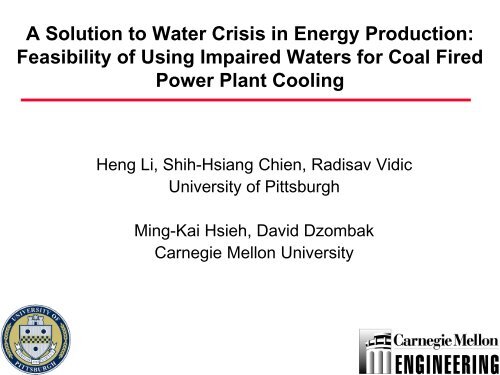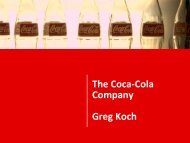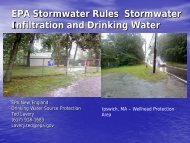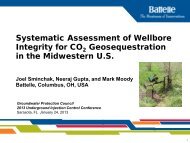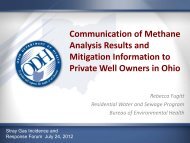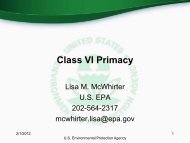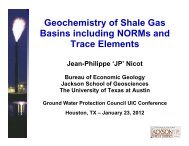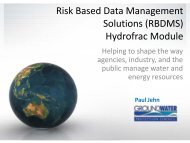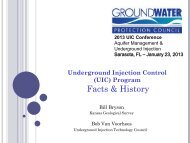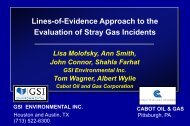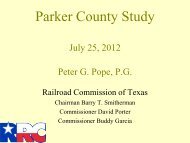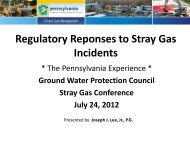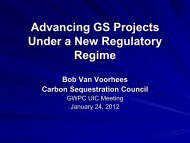NETL - cooling water
NETL - cooling water
NETL - cooling water
You also want an ePaper? Increase the reach of your titles
YUMPU automatically turns print PDFs into web optimized ePapers that Google loves.
A Solution to Water Crisis in Energy Production:<br />
Feasibility of Using Impaired Waters for Coal Fired<br />
Power Plant Cooling<br />
Heng Li, Shih-Hsiang Chien, Radisav Vidic<br />
University of Pittsburgh<br />
Ming-Kai Hsieh, David Dzombak<br />
Carnegie Mellon University
OVERVIEW<br />
• Water-Energy Nexus<br />
• Water requirements in thermoelectric power<br />
production<br />
• Alternative <strong>water</strong>s for power plant <strong>cooling</strong><br />
• Research materials and methods<br />
• Results and discussions<br />
• Summary
WATER-ENERGY NEXUS<br />
Current Approach:<br />
• Planning for future electricity production without<br />
considering how <strong>water</strong> requirements will be met<br />
over time, and<br />
• Planning for future <strong>water</strong> resources with the<br />
assumption that electricity will be readily<br />
availability<br />
Energy-<strong>water</strong> relationship:<br />
• Need electricity to produce <strong>water</strong><br />
• Need <strong>water</strong> to produce electricity
Water Use in Thermoelectric Power Plants<br />
Water-Intensive<br />
Processes<br />
Water vapor<br />
Steam cycle<br />
Steam<br />
Turbine<br />
Cooling <strong>water</strong><br />
Water vapor<br />
Cooling tower<br />
Additional<br />
Processes<br />
Heat<br />
Source<br />
Condenser<br />
Other Cooling<br />
Requirements<br />
Wet Solid<br />
Waste<br />
Process<br />
<strong>water</strong><br />
make-up<br />
Boiler<br />
feed<strong>water</strong><br />
make-up<br />
Cooling<br />
tower<br />
make-up<br />
Cooling <strong>water</strong><br />
blowdown<br />
Raw <strong>water</strong> source (river, lake, ocean, well, municipal system, etc.)
THERMOELECTRIC POWER GENERATION<br />
AND WATER<br />
• 2000 thermoelectric <strong>water</strong><br />
Public Supply, 13%<br />
U.S. Fresh<strong>water</strong> Withdrawal (2000)<br />
Domestic, 1%<br />
Irrigation, 40%<br />
requirements:<br />
– Withdrawal: ~ 136 BGD<br />
– Consumption: ~ 4 BGD<br />
U.S. Fresh<strong>water</strong> Consumption (1995)<br />
Thermoelectric, 39%<br />
Mining, 1%<br />
Livestock, 1%<br />
Aquaculture, 1%<br />
Commercial, 1%<br />
Thermoelectric, 3%<br />
Domestic, 6%<br />
Mining, 1%<br />
Industrial, 5%<br />
Industrial, 3%<br />
• Thermoelectric power plants compete<br />
Livestock, 3%<br />
with other use sectors.<br />
Irrigation, 81%<br />
Sources: USGS, 1998, 2004
HI<br />
AK<br />
AK<br />
AK<br />
HI<br />
HI<br />
HI<br />
HI<br />
HI<br />
HI<br />
HI<br />
HI HI<br />
HI<br />
HI<br />
HI<br />
HI<br />
HI<br />
OR<br />
OR WA<br />
ID<br />
ID<br />
SD<br />
MI<br />
MN<br />
WI<br />
MI<br />
MA<br />
WY<br />
LIMITATIONS IN WATER AVAILABILITY CT RI<br />
MT<br />
ND SD<br />
WI<br />
ME<br />
MI<br />
NY MA<br />
WY<br />
IA<br />
PA FOR<br />
NE<br />
MN<br />
NJ<br />
CTRI<br />
OR<br />
MI<br />
VT<br />
NV ID<br />
NH<br />
OH<br />
UT<br />
IL<br />
MD<br />
SD<br />
WI IA<br />
DE<br />
MI<br />
NY PA<br />
MA<br />
CA POWER CO PLANT<br />
NE<br />
NJ<br />
COOLING<br />
WV<br />
WY<br />
CTRI<br />
Survey Responses<br />
Extent of State Shortages Likely over the Next Decade<br />
NV<br />
KS MO<br />
VA OH<br />
UT<br />
KY IL IN<br />
MDDE<br />
IA<br />
PA<br />
NE<br />
NJ<br />
CA<br />
CO<br />
WV<br />
NV<br />
NC<br />
TN<br />
OH<br />
UT<br />
KS<br />
OK<br />
ILMO<br />
IN<br />
MDDE<br />
VA<br />
AZ<br />
KY<br />
CA<br />
NM CO<br />
AR<br />
WV SC<br />
under Average Water Conditions<br />
KS MO<br />
VA NC<br />
MS AL KY GA TN<br />
OK<br />
WAAZ<br />
NC<br />
NM TX<br />
AR TN<br />
SC<br />
OK LA<br />
AZ<br />
NM MT<br />
ME<br />
ND<br />
AR<br />
SC<br />
MS AL<br />
FL GA<br />
MN<br />
OR<br />
MS AL MI GA<br />
VT<br />
ID<br />
NH<br />
TX<br />
TX SD<br />
LAWI<br />
MI<br />
NY<br />
LA<br />
MA<br />
WY<br />
CTRI<br />
IA<br />
FL FL<br />
PALegend<br />
NE<br />
NJ<br />
NV<br />
OH<br />
UT<br />
IL IN shortageMDDE<br />
CA<br />
CO<br />
WV Statewide<br />
KS MO<br />
VA<br />
KY Regional<br />
Legend<br />
AZ<br />
NM<br />
Local NC<br />
TN shortage<br />
OK<br />
None<br />
AR<br />
SC Statewide shortage<br />
No response or uncertain<br />
MS AL GA Regional Statewide<br />
Local Regional<br />
TX<br />
LA<br />
None<br />
Local<br />
AK<br />
No FL response or uncertain<br />
MI<br />
NY<br />
VT NH<br />
VT NH<br />
None<br />
Legend<br />
No response or uncertain<br />
HI<br />
Source: US Government Accountability Office2003<br />
HI<br />
HI<br />
HI<br />
HI<br />
Legend<br />
shortage<br />
Statewide<br />
Regional<br />
Local<br />
None<br />
No response or uncertain
Expected Cooling Water Shortage in 2025<br />
Source: Roy et al., (2003) A Survey of Water<br />
Use and Sustainability in the United States with<br />
a Focus on Power Generation. EPRI
POSSIBLE ALTERNATIVE SOURCES OF<br />
COOLING WATER<br />
Municipal<br />
Waste<strong>water</strong><br />
Ash Pond Water<br />
Abandoned Mine Drainage
REUSE OF MUNICIPAL WASTEWATER<br />
IN THE COOLING SYSTEMS OF<br />
THERMOELECTRIC POWER PLANTS<br />
• 11.4 trillion gallons of municipal waste<strong>water</strong><br />
collected and treated annually in U.S.<br />
• Experience with use of treated municipal<br />
<strong>water</strong> for power plant <strong>cooling</strong> in arid west;<br />
e.g., Burbank, Las Vegas, Phoenix<br />
• Significant additional treatment beyond<br />
secondary treatment (e.g., clarification,<br />
filtration, N and P removal)
INVENTORY OF AVAILABLE MUNICIPAL<br />
WASTEWATER<br />
GIS-based tool developed to assess availability of<br />
secondary effluent from publicly owned treatment works<br />
(17864 POTWs in lower 48 states).
INVENTORY OF WATER NEEDS<br />
• 110 proposed power plants from EIA annual report 2007<br />
• U.S. is divided into major NERC regions
Percentage, %<br />
POWER PLANTS WITH SUFFICIENT MUNICIPAL<br />
WASTEWATER FOR COOLING<br />
100<br />
92<br />
80<br />
81<br />
76<br />
60<br />
49<br />
40<br />
20<br />
0<br />
10 25<br />
Coverage radius, mile<br />
Proposed Power Plants<br />
Existing Power Plants
SUMMARY – WASTEWATER AVAILABILITY<br />
• POTWs located within 10 and 25 mile radius from<br />
the proposed power plants can satisfy 81% and<br />
92% of proposed and 49% and 76% of existing<br />
power plant <strong>cooling</strong> <strong>water</strong> needs, respectively.<br />
• On average, one fairly large POTW can<br />
completely satisfy the <strong>cooling</strong> <strong>water</strong> demand for<br />
each of these power plants.
KEY TECHNICAL CHALLENGES WITH<br />
THE USE OF IMPAIRED WATERS<br />
• Precipitation and scaling<br />
• Accelerated corrosion<br />
• Biomass growth
CORROSION AND SCALING CONTROL<br />
Categories<br />
Corrosion control<br />
Inorganic-anodic<br />
Inorganic-cathodic<br />
Organic inhibitors<br />
Agents<br />
Chromate<br />
Nitrite<br />
Nitrate<br />
Molybdate<br />
Orthophosphate<br />
Silicates<br />
Zinc<br />
Polyphosphate<br />
Azoles<br />
Amines and fatty polyamines<br />
Consideration for<br />
Study<br />
No<br />
No<br />
No<br />
No<br />
Yes<br />
No<br />
Yes<br />
Yes<br />
Yes<br />
No<br />
Scaling and fouling control<br />
Chelant Glucoheptonates No<br />
Amines and fatty polyamines No<br />
Traditional inhibitors<br />
Phosphonates<br />
Yes<br />
Phosphate esters<br />
No<br />
Polycarboxylic acid (PCA)<br />
No<br />
Polymer<br />
Polyacrylates (PAA)<br />
Yes<br />
Polymaleic acid (PMA)<br />
Yes<br />
Natural dispersants<br />
Ligno-sulfonates<br />
No<br />
Tannins<br />
No
Bench-scale Water Recirculating System:<br />
Scaling and Biofouling
Bench-scale Water Recirculating System:<br />
Corrosion Studies<br />
Potentiostat PT<br />
Electrode<br />
Recirculating flow<br />
Flow meter<br />
Electrode holder<br />
Pump<br />
P<br />
Synthetic<br />
waste<strong>water</strong><br />
Valve<br />
Hot plate
CORROSION CRITERIA FOR<br />
COMMONLY USED ALLOYS<br />
Source: Puckorius, (2003) Cooling Water System<br />
Corrosion Guidelines. Process Cooling & Equipment.<br />
10 MPY<br />
Unacceptable<br />
5 MPY<br />
3 MPY<br />
1 MPY<br />
Poor<br />
Fair<br />
Good<br />
Excellent<br />
0.5 MPY<br />
0.3 MPY<br />
0.2 MPY<br />
0.1 MPY<br />
Mild steel piping<br />
Copper and copper alloys
PILOT SCALE COOLING TOWERS<br />
Franklin Township Municipal<br />
Sanitary Authority, Murrysville, PA
Pilot-Scale Water Recirculating System<br />
Biocide tank<br />
Heater<br />
Coupon/Electrode rack
Chemical Treatment Programs for Secondary<br />
Treated Municipal Waste<strong>water</strong><br />
Agents<br />
Tower<br />
A1<br />
Target chemical agent conc. (ppm)<br />
Tower<br />
B1<br />
Tower<br />
C1<br />
Tower<br />
A2<br />
Tower<br />
B2<br />
TTA 2 1 2 2 0<br />
TKPP 10 0 10 0 0<br />
PMA 10 0 20 10 0<br />
PBTC 5 0 10 0 0<br />
MCA 1-2 1-2 1-2 3-4 3-4
Corrosion Rates in Cooling Towers<br />
Average corrosion rate category<br />
Metal alloys Tower A1 Tower B1 Tower C1 Tower A2 Tower B2<br />
Mild steel<br />
(21-day avg.)<br />
Mild steel<br />
(last 5 days avg.)<br />
Copper<br />
(21-day avg.)<br />
Copper-nickel<br />
(21-day avg.)<br />
excellent good fair poor unaccep.
Deposits (mg)<br />
Relative amount<br />
Scaling Rates in Cooling Towers<br />
30<br />
25<br />
20<br />
15<br />
10<br />
Disc number<br />
0 1 2 3 4 5 6<br />
7<br />
8<br />
9<br />
Tower C (PMA-PBTC 20/10ppm)<br />
Tower B (blank)<br />
Tower A (PMA-PBTC 10/5ppm)<br />
5<br />
0<br />
0 5 10 15 20 25<br />
Immersion time (day)<br />
100%<br />
unburnable mass<br />
burned mass<br />
75%<br />
50%<br />
25%<br />
0%<br />
7 8 9<br />
Coupon disc number
SUMMARY: SCALING AND CORROSION<br />
• Several scale inhibitors were effective in the<br />
absence of disinfectants<br />
• Phosphate, either present in the makeup <strong>water</strong><br />
or added as corrosion inhibitor, worsened<br />
scaling<br />
• Ammonia could accelerate corrosion and<br />
mitigate scaling, but was stripped in the <strong>cooling</strong><br />
tower<br />
• In general, except for aluminum (pitting in all<br />
situations), corrosion rates of alloys were within<br />
acceptable range
SUMMARY: BIOFOULING<br />
• Addition of chlorine impaired the<br />
effectiveness of the antiscalants and<br />
accelerated corrosion<br />
• Chloramine was an effective biocide<br />
and much less corrosive than chlorine<br />
• Continuous monochloramine dosing to<br />
achieve 3 – 4 ppm as Cl 2 successfully<br />
inhibited biomass growth with planktonic<br />
heterotrophic plate count under 10 4<br />
CFU/ml and sessile heterotrophic plate<br />
count under 10 4 CFU/cm 2
ADDITIONAL ISSUES WITH THE USE<br />
OF IMPAIRED WATERS<br />
• Pretreatment before use vs. extensive chemical<br />
addition to the <strong>cooling</strong> tower<br />
• LCA of the alternatives<br />
• Regulatory issues<br />
• Social issues
Acknowledgement<br />
U.S. DOE – National Energy Technology Laboratory<br />
“Reuse of Treated Internal or External Waste<strong>water</strong>s in the Cooling<br />
Systems of Coal-based Thermoelectric Power Plants”<br />
(Grant # DE-FC26-06NT42722)<br />
Jim Brucker and Gene Greco<br />
Franklin Township Municipal Sanitary Authority (Murrysville, PA)


